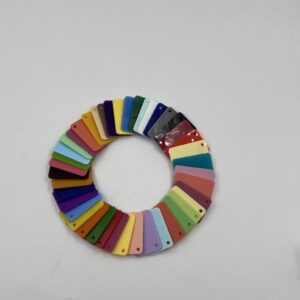Summary
Acrylic displays have emerged as a pivotal element in retail merchandising, known for their clarity, durability, cost-effectiveness, and aesthetic appeal. These displays are favored by retailers seeking to enhance product visibility and engage customers, owing to their ability to transmit up to 92% of light without the greenish tint associated with glass, thus ensuring an unobstructed view of displayed items. With the ability to be easily customized to align with brand identity, acrylic displays offer extensive versatility, allowing retailers to craft visually appealing environments that attract shopper attention.
Table of Contents
Despite their advantages, acrylic displays are not without challenges. Issues such as visibility problems caused by inadequate lighting, overcrowded arrangements leading to clutter, and the environmental impact of acrylic production have sparked discussions among retailers and consumers alike. The durability of acrylic, while beneficial, raises questions regarding sustainability, prompting retailers to seek eco-friendly alternatives and practices that can mitigate these concerns. Additionally, while maintenance is generally low, retailers must be vigilant against scratches and discoloration over time, necessitating a structured upkeep strategy to preserve the displays’ visual appeal.
To maximize the effectiveness of acrylic displays, retailers are encouraged to adopt strategic practices. This includes embracing sustainable manufacturing methods, optimizing display designs for efficiency, and employing advanced technologies like predictive analytics to improve inventory management and reduce waste. Collaborating closely with suppliers can further refine display strategies, ensuring alignment with business goals and enhancing operational efficiency.
Overall, the efficient use of acrylic displays presents both opportunities and chal- lenges within the retail landscape. By addressing common issues and implementing innovative strategies, retailers can significantly enhance the shopping experience while fostering sustainability in their merchandising efforts.

Benefits of Acrylic Displays
Acrylic displays have become a popular choice in retail environments due to their numerous advantages that enhance visual merchandising and product presentation.
Cost-Effectiveness
Finally, acrylic displays provide a cost-effective solution compared to glass or metal options. Their affordability, combined with reduced shipping and setup costs due to their lightweight nature, allows retailers greater flexibility in their display strategies. This financial advantage makes acrylic displays an attractive option for businesses looking to optimize their visual merchandising efforts while staying within budget constraints.
Clarity and Transparency
One of the most significant benefits of acrylic displays is their exceptional clarity, allowing for an unobstructed view of the products on display. This transparency highlights the features of merchandise, making it more appealing to potential cus- tomers. Acrylic can transmit up to 92% of light, providing a clear view of products without the greenish tint often found in glass, further enhancing visibility and customer engagement.
Durability and Safety
Acrylic displays are known for their durability, as they are shatter-resistant and can withstand high-traffic conditions without compromising safety. Unlike glass, which can break easily, acrylic remains intact, making it a safer choice for retail settings. Additionally, the lightweight nature of acrylic facilitates easy transportation and rearrangement of displays, enabling retailers to adapt quickly to changing mer- chandising strategies.
Low Maintenance
The maintenance of acrylic displays is straightforward, as they can be easily cleaned without streaking or smudging, unlike glass. This low-maintenance character- istic ensures that merchandise remains visually appealing at all times, contributing to a positive shopping experience for customers and allowing business owners to focus on customer engagement rather than upkeep.
UV Resistance
Another essential feature of acrylic displays is their UV resistance, which protects products from sun damage. This quality is particularly important for preserving the vibrancy and integrity of displayed merchandise over time. Retailers looking to maintain the quality of their products find this aspect especially beneficial.
Customization Options
Acrylic displays offer extensive customization options, making it easy for retailers to tailor displays to align with brand identity and marketing strategies. Various shapes, sizes, colors, and lighting can be utilized to create engaging and visually
stimulating displays that attract customer attention. This level of customization can enhance the overall shopping experience and effectively communicate a brand’s personality.

Common Challenges in Using Acrylic Displays
Acrylic displays are popular in retail settings due to their clarity, durability, and cost-effectiveness. However, several challenges can arise when using these displays, which retailers must navigate to maximize their effectiveness.
Visibility Issues
While acrylic displays provide transparency that showcases merchandise, they can also present visibility challenges if not properly designed. Dim or harsh lighting can detract from the attractiveness of acrylic displays, making it difficult for shoppers to see and appreciate the products being showcased. Ensuring appropriate lighting that highlights key items while creating a welcoming atmosphere is crucial for maintaining product appeal.
Overcrowding and Clutter
One of the most common mistakes with acrylic displays is overcrowding. When too many products are displayed together, it can overwhelm customers, leading to a visually unappealing setup. Retailers must be mindful of the arrangement of products, ensuring that displays are organized and allow for easy movement and product access. A cluttered display can inhibit impulse buys and contribute to choice paralysis among shoppers, reducing overall sales effectiveness.
Durability vs. Environmental Concerns
While acrylic is known for its durability and shatter resistance, it also poses chal- lenges in terms of environmental sustainability. The production of acrylic displays can involve processes that are not environmentally friendly, leading to increased scrutiny from consumers and regulatory bodies. Retailers must balance the benefits of acrylic’s durability with the need for eco-friendly practices, such as using recycled materials and designing for recyclability, which can complicate display manufacturing and sourcing strategies.
Cost Management
Although acrylic displays are generally more affordable than glass or metal alterna- tives, the costs can accumulate when considering custom designs and the need for frequent updates due to changing merchandise. Retailers should weigh the initial savings against the long-term expenses associated with maintaining and updating these displays to ensure that their investments yield maximum returns.
Maintenance Challenges
While acrylic displays are easy to clean and maintain, they can be prone to scratches and discoloration over time. Retailers need to implement a regular maintenance schedule to keep displays looking their best, which can be resource-intensive.
Furthermore, keeping displays free from fingerprints and smudges is essential for maintaining product visibility and overall aesthetic appeal. By addressing these challenges, retailers can enhance the effectiveness of their acrylic displays and create an engaging shopping experience for their customers.

Strategies for Enhancing Efficiency
Sustainable Manufacturing Practices
Enhancing the efficiency of acrylic displays in retail settings starts with adopting sustainable manufacturing practices. Key strategies include optimizing energy usage and transitioning to renewable energy sources during production. Utilizing recycled acrylic materials not only reduces waste but also promotes environmental sustain- ability. Additionally, manufacturers are encouraged to implement 5S practices in their operations to enhance workplace efficiency, minimize clutter, and ultimately reduce material waste.
Design Optimization
Design optimization plays a critical role in enhancing the efficiency of retail displays. Employing advanced techniques such as CNC cutting optimization and precise 3D modeling can significantly minimize material waste during production. Moreover, designing for product longevity and recyclability ensures that displays maintain their functionality while being easier to repurpose or recycle at the end of their lifecycle. Incorporating modular and disassemblable units also allows for quick assembly and reconfiguration, aligning with the dynamic needs of retail environments.
Predictive Analytics and Artificial Intelligence
The integration of predictive analytics and artificial intelligence can further enhance efficiency in acrylic display manufacturing. These technologies can improve material usage by accurately predicting requirements, optimizing cutting patterns, and pre- venting overstocking, thereby reducing unnecessary waste. Retailers can leverage these insights to make data-driven decisions regarding inventory management and display strategies.
Collaboration with Suppliers
Collaborating with suppliers is essential for refining store layouts and enriching planogram strategies. Suppliers often possess valuable insights into product per-
formance, which can lead to mutually beneficial arrangements such as dedicated display areas for specific brands. By working closely with suppliers, retailers can ensure that their display strategies align with broader business goals, thus enhancing overall operational efficiency.
Emphasizing Certifications and Compliance
To bolster sustainability efforts and enhance efficiency, manufacturers should priori- tize certifications such as ISO 14001 and the Forest Stewardship Council (FSC) for their materials. These certifications not only ensure compliance with environmental standards but also provide transparency and accountability in the supply chain. Compliance with regulations like REACH (EU) or CA Prop 65 is crucial for interna- tional brands, ensuring that all materials used in displays meet the necessary health and safety standards. By implementing these strategies, retailers can significantly enhance the efficiency of their acrylic displays, creating a more sustainable and effective retail environment.
Maintenance and Care for Acrylic Displays
Proper maintenance and care are essential for ensuring the longevity and aesthetic appeal of acrylic displays in retail settings. Regular inspections and upkeep not only prevent minor issues from escalating but also project a professional image to customers.
Cleaning Best Practices
Cleaning acrylic displays is a straightforward process that requires minimal effort. It is recommended to use a soft microfiber cloth along with a mild cleaner or a simple solution of soap and water to maintain clarity and shine. Harsh chemicals, especially those containing ammonia, should be avoided as they can damage the material over time. Regular cleaning prevents dust accumulation and keeps the displays looking polished, enhancing the overall presentation of the store.
Handling Guidelines
Careful handling of acrylic displays is crucial, especially in high-traffic areas. To minimize wear and tear, displays should be lifted rather than dragged during setup changes. This not only preserves the integrity of the acrylic but also helps main- tain its clear appearance. Additionally, understanding the strengths and limitations of acrylic will empower users to handle displays appropriately, reducing the risk of scratches and cracks.
Routine Maintenance
Establishing a routine maintenance schedule is beneficial for long-term investment. Regular inspections should include checking for any signs of wear, which can help
identify small problems before they become significant issues. By adopting these practices, retailers can ensure their acrylic displays continue to function effectively while providing a visually appealing presentation that captures customer interest.
Eco-Friendly Considerations
Despite some misconceptions regarding acrylic’s environmental impact, advance- ments in recycling and sustainable sourcing are making it a more eco-conscious choice. Choosing high-quality acrylic that can be recycled at the end of its lifecycle supports sustainability efforts and reduces overall waste. Thus, retailers not only benefit from the durability and low maintenance of acrylic displays but also contribute to a more sustainable retail environment.

Case Studies
Importance of Case Studies in Acrylic Displays
Case studies play a critical role in demonstrating the effectiveness and versatility of acrylic displays in retail settings. By presenting well-crafted case studies, companies can showcase their expertise and the tangible benefits of their products, thereby positioning themselves as industry leaders. These studies typically include thor- ough research, clear objectives, design solutions, and quantifiable outcomes, which collectively build trust and credibility with potential clients.
Building Trust and Credibility
When sales teams incorporate case studies into their outreach efforts, they can sig- nificantly enhance their chances of converting prospective clients. A well-timed case study shared during a sales pitch can illustrate how similar businesses successfully utilized acrylic displays to achieve their goals. For example, a case study detailing a museum’s use of acrylic display cases to showcase fragile artifacts can serve as a testament to the material’s properties and versatility, reinforcing the brand’s reliability.
Continuous Improvement and Innovation
Analyzing the results from case studies also provides invaluable feedback on the performance of acrylic products in real-world applications. This insight enables com- panies to identify what works well and what areas require improvement, fostering continuous innovation in their product offerings.
Examples of Successful Acrylic Display Applications
Successful implementations of acrylic displays offer inspiration for future designs. For instance, layering different sizes of acrylic displays can create depth, drawing customers’ eyes to focal points in a store. Additionally, the integration of lighting within these displays can enhance product visibility, making merchandise more appealing. Such creative applications not only elevate the retail space but also convey the brand’s personality effectively.
Marketing and Sales Strategies
Case studies are also powerful assets for marketing and sales strategies. When used as part of a content marketing strategy, they can be featured in blogs, newsletters, and social media campaigns, effectively engaging customers and generating interest in acrylic products. For instance, an acrylic products brand might create a detailed case study that combines product application with insights into the design process, sharing this content across various platforms to foster customer interaction and brand awareness.

















